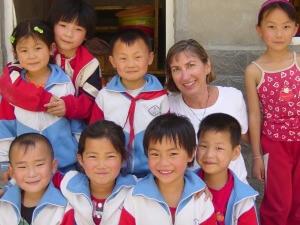Patricia Riley, Associate Professor of Music Education (pictured at left with students), has recently returned from her third trip to China. Riley went to China for the first time in 2009 to conduct research regarding student music composition and cultural context. In searching for a school in which to conduct this research, she was introduced to an Executive Director of a Non-Governmental Organization (NGO), The China Schools Foundation, who was able to place her in an elementary school in Xi'an. Since then, she has become active in the NGO's project to upgrade education, and more specifically music education in China's rural schools. For the past two years she has been working closely with this NGO on curriculum development, and on providing support for rural teachers to begin implementing these curricular ideas, as well as more progressive teaching strategies.
In May and June of 2009, Riley worked in four rural Chinese schools in Shaanxi Province connected with this NGO, as well as with another NGO in Shanxi Province, The Rural China Education Foundation, providing "model" lessons and conducting teacher training workshops. These workshops included developing lesson plans for four 2nd- and 5th-grade model lesson, conferencing with teachers and administrators about the pedagogical methods and lesson goals, teaching the model lessons, and mentoring the Chinese teachers in their practicing and delivering of the lessons. The lessons taught by the Chinese teachers were videotaped to become the sample forerunners of a library of support materials for rural teachers being developed by the China Schools Foundation. The textbooks used in the Chinese rural schools are basically songbooks; and with little or no exception, teachers do not address any music concepts or learning beyond the singing of the songs. The model lessons use songs from the textbooks already in practice, but demonstrate hands-on learning, group work, differentiated instruction, and constructivist theory. In addition to singing the songs, the model lessons also engage the children in playing rhythm and mallet-percussion instruments, listening, movement, improvising, and composing activities.
In May 2010, Riley returned to China to continue work within this project. This time, a professional film crew was hired to more adequately capture the model lessons; and the scope of the lessons was expanded to include lessons for every primary grade level, pre-kindergarten through sixth-grade. After a practice session at a migrant school in Beijing designed to acclimate the film crew to the classroom procedures, all of the lessons occurred at the Shuangling Primary School in Shaanxi Province. During this visit, 14 model lessons were taught by Riley, and after a substantial amount of mentoring, re-taught by classroom teachers at the school. The film crew captured the children’s responses during Riley’s teaching, and the Chinese teachers’ delivery during the re-teaching of each lesson. Many teachers and administrators at the Shuangling Primary School observed the lessons, and on one occasion, teachers and administrators from other area schools, as well as a government official, Long Xiaofan from the Fuping Teaching and Research Section, visited. Long’s presence and extraordinarily complementary remarks during the post-observation banquet were very important to the Project, since China’s school reform efforts call for children becoming less “passive” in their classroom participation, and the China Schools Foundation’s Model Lessons Program exemplifies this more active, child-centered pedagogy. It is expected that the Model Lesson videotapes will be distributed throughout all of Shaanxi Province, as well as other provinces in rural China.

Professor Works to Improve Rural Chinese Music Education
ShareJuly 12, 2010